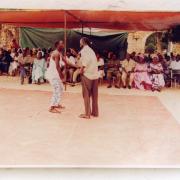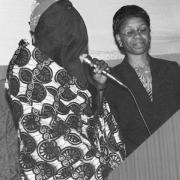Using smartphones to advance safety and protection in public places
"SafeNess" is a mobile application, running on Android and iOS system, that allows the user to act quickly in case of dangers encoun


"SafeNess" is a mobile application, running on Android and iOS system, that allows the user to act quickly in case of dangers encoun
The Ruta Pacífica is a movement of Colombian women who have directly confronted the violence of the armed actors with large mobilizations of caravans, marches, and public events, crossing the country and entering conflict zones under military control. There, the women of the Ruta have broken the silence in order to mobilize the voices for peace in their country.
Human rights practitioners are often located in the Non-governmental Organizations (NGOs) of big cities, while most of the crisis situations, the need for monitoring and defense of human rights are located in rural areas. In Chiapas, Mexico, the rural indigenous communities have been confronting years of repression and harassment. This tactic case study describes the model of the Network of Human Rights Defenders, organized in Chiapas by Miguel Angel de los Santos.
The Otpor! student movement in Serbia built a broad constituency of support by continuously innovating and combining tactics to ensure the safety of their volunteers and break down the fear of its people to speak out against the government. The content of the notebook focuses on “Plan B,” one tactic they used to do this. When Serb authorities began arresting demonstrators, Otpor!’s support base could have disintegrated due to fear.
Government corruption in Turkey had been an open secret. Yet, the public felt apathetic about their ability to change the situation. The Campaign of Darkness for Light gave people an easy and no-risk action everyone could take – simply turning off their lights at the same time each evening – and thus show their displeasure with the system. Such a simple action – a flick of the switch – and yet when people saw that their neighbors had turned off their lights, too, they felt the power of their collective voices. 30 million people turned off and on their lights to demand that the government act against corruption, soon they began to invent their own ways to speak out by gathering on the streets, marching and banging pots and pans.
 Oulimata Gaye and her organization Réseau Africain pour le Développement Intégré (RADI) break the wall of silence that cloaks violence against women in Senegal. How do we begin to “repair” human rights problems when people will not speak of them? How do we make people talk about them? The tool used here is theater. At times amusing, at times sad, the sketches involve the audience, literally and metaphorically, in familiar situations.
Oulimata Gaye and her organization Réseau Africain pour le Développement Intégré (RADI) break the wall of silence that cloaks violence against women in Senegal. How do we begin to “repair” human rights problems when people will not speak of them? How do we make people talk about them? The tool used here is theater. At times amusing, at times sad, the sketches involve the audience, literally and metaphorically, in familiar situations.
 BAOBAB for Women’s Human Rights, in collaboration with the Civil Resource Development and Documentation Centre (CIRDDOC), highlighted violations of women’s rights in Nigeria that were viewed by the public as normal or even justifiable abuse. They used a mock tribunal to change public perceptions and beliefs regarding violations against women, and changed public policy and law.
BAOBAB for Women’s Human Rights, in collaboration with the Civil Resource Development and Documentation Centre (CIRDDOC), highlighted violations of women’s rights in Nigeria that were viewed by the public as normal or even justifiable abuse. They used a mock tribunal to change public perceptions and beliefs regarding violations against women, and changed public policy and law.
Summary available
Thank you for joining Tactical Tech and the New Tactics online community for an online conversation on Using Humor to Expose the Ridiculous from January 14 to 18. All over the world, activists use humour, irony, satire, parody and lampooning to express dissent and challenge the absurdities of institutional power. Through culture jamming, which embodies all these tactics and more, they interrupt the flow of information controlled by governments, corporations, the advertising industry, media corporations, fundamental religious leaders and other powerful people in society. In doing so, they expose the lies, deceptions and sheer absurdities in their speech.
This online conversation was an opportunity to exchange experiences, lessons-learned and ideas among practitioners using humor to challenge regimes and societies, and provoke citizens to reevaluate the way they think, and sometimes even push them to join them in their campaigns.
Summary available
Thank you for joining Nadine Bloch and the New Tactics community for this conversation on Cultural Resistance. Cultural resistance is the broad use of arts, literature, and traditional practices to challenge or fight unjust or oppressive systems and/or power holders within the context of nonviolent actions, campaigns and movements. At its core, cultural resistance is a way of reclaiming our humanity, and celebrating our work as individuals and communities. Cultural resistance tactics are particularly powerful because they serve multiple purposes. They inspire us to own our lives and invest in our communities, while building capacity for local leadership. These creative and artistic tactics provide a fun way for people to get involved!